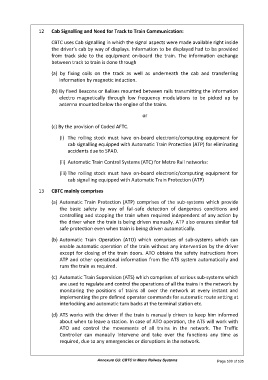Page 566 - IRSEM_Main Book
P. 566
12 Cab Signalling and Need for Track to Train Communication:
CBTC uses Cab signalling in which the signal aspects were made available right inside
the driver’s cab by way of displays. Information to be displayed had to be provided
from track side to the equipment on-board the train. The information exchange
between track to train is done through
(a) by fixing coils on the track as well as underneath the cab and transferring
information by magnetic induction.
(b) By fixed Beacons or Balises mounted between rails transmitting the information
electro magnetically through low frequency modulations to be picked up by
antenna mounted below the engine of the trains.
or
(c) By the provision of Coded AFTC.
(i) The rolling stock must have on-board electronic/computing equipment for
cab signalling equipped with Automatic Train Protection (ATP) for eliminating
accidents due to SPAD.
(ii) Automatic Train Control Systems (ATC) for Metro Rail networks:
(iii) The rolling stock must have on-board electronic/computing equipment for
cab signalling equipped with Automatic Train Protection (ATP)
13 CBTC mainly comprises
(a) Automatic Train Protection (ATP) comprises of the sub-systems which provide
the basic safety by way of fail-safe detection of dangerous conditions and
controlling and stopping the train when required independent of any action by
the driver when the train is being driven manually. ATP also ensures similar fail
safe protection even when train is being driven automatically.
(b) Automatic Train Operation (ATO) which comprises of sub-systems which can
enable automatic operation of the train without any intervention by the driver
except for closing of the train doors. ATO obtains the safety instructions from
ATP and other operational information from the ATS system automatically and
runs the train as required.
(c) Automatic Train Supervision (ATS) which comprises of various sub-systems which
are used to regulate and control the operations of all the trains in the network by
monitoring the positions of trains all over the network at every instant and
implementing the pre defined operator commands for automatic route setting at
interlocking and automatic turn backs at the terminal station etc.
(d) ATS works with the driver if the train is manually driven to keep him informed
about when to leave a station. In case of ATO operation, the ATS will work with
ATO and control the movements of all trains in the network. The Traffic
Controller can manually intervene and take over the functions any time as
required, due to any emergencies or disruptions in the network.
Annexure G3: CBTC in Metro Railway Systems Page 509 of 535

